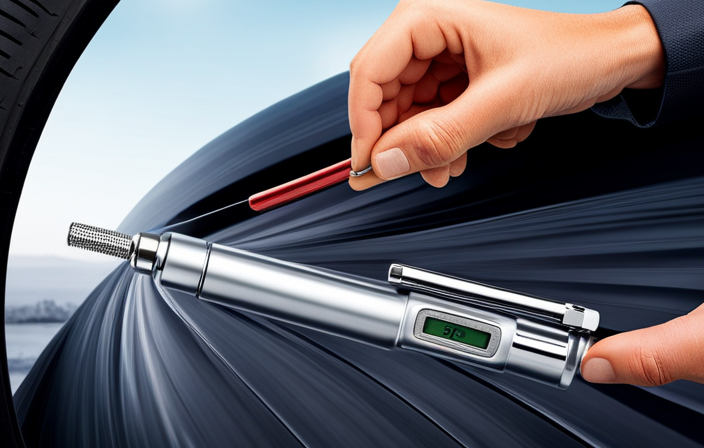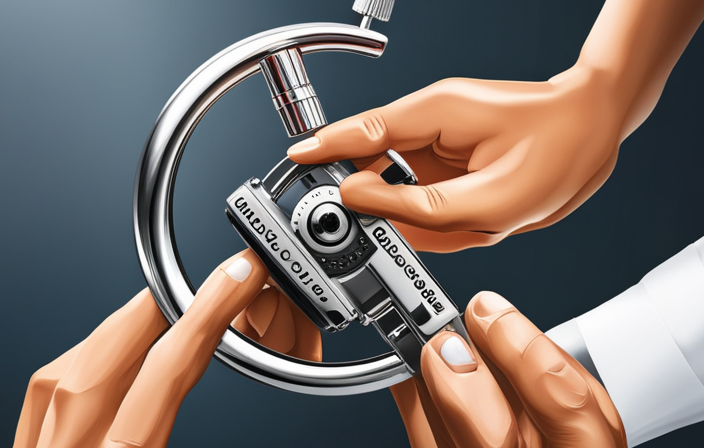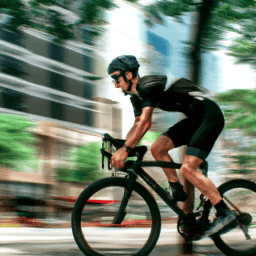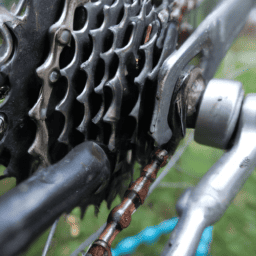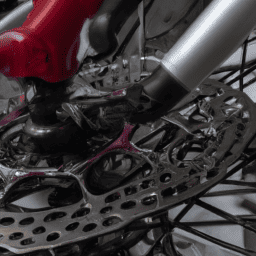Not sure how much air should be in your bicycle tires? No problem, I can help you out.
In this article, we’ll explore the importance of tire pressure, the different factors that influence it, and the recommended ranges for various bike types. Understanding these key elements will not only enhance your riding experience but also improve your bike’s performance and safety.
So, let’s dive in and discover the optimal tire pressure for your bicycle.
Key Takeaways
- Proper tire pressure is important for enhancing riding experience and safety.
- Maintaining the optimal tire pressure extends tire lifespan and improves rider comfort.
- Adjusting tire pressure based on terrain and understanding the relationship between tire width and pressure is crucial.
- Regularly checking and adjusting tire pressure, especially in response to temperature changes, is necessary for optimal performance and safety.
Importance of Proper Tire Pressure
Proper tire pressure is essential for ensuring a smooth and safe ride on your bicycle. Understanding inflation methods and the link between tire pressure and traction is crucial in maintaining optimal performance.
When it comes to tire pressure, it is important to strike a balance. If the pressure is too low, it can cause the tires to feel sluggish and increase the risk of pinch flats. On the other hand, if the pressure is too high, it can lead to a harsh ride and reduced traction.
By finding the right tire pressure, you can improve your bike’s handling and responsiveness, making your rides more enjoyable.
In the subsequent section about understanding tire types and their recommended pressure, we will further explore this topic.
Understanding Tire Types and Their Recommended Pressure
To ensure optimal performance, it is important to understand the different types of tires and their recommended pressure.
The correlation between rider weight and tire pressure is crucial. It helps determine the right amount of air to put in your bicycle tires.
Heavier riders require higher tire pressure to support their weight and prevent pinch flats. On the other hand, lighter riders can get away with lower pressure for a smoother ride.
In addition to rider weight, different terrains and conditions also play a role in determining the ideal tire pressure.
For rough terrains, a lower pressure provides better traction and absorbs shocks. On the other hand, higher pressure is ideal for smoother surfaces to minimize rolling resistance.
Considering these factors will help you find the perfect tire pressure for your specific needs.
Now, let’s consider your rider weight for optimal tire pressure.
Consider Your Rider Weight for Optimal Tire Pressure
When determining the optimal tire pressure, it is important to take into account your weight as a rider. Rider weight considerations play a crucial role in determining the right tire pressure for your bicycle. This is because the amount of air in your tires affects the way they interact with the road surface, ultimately impacting your speed and performance.
Here are three key factors to consider:
-
Weight distribution: Ensure that the weight is evenly distributed between the front and rear tires for optimal handling and control.
-
Tire contact area: A heavier rider will naturally have a larger contact area between the tires and the road. Adjusting the tire pressure accordingly can help optimize this contact for better traction.
-
Speed and comfort: Higher tire pressure can increase speed, but it may sacrifice comfort. Finding the right balance is essential for a smooth and efficient ride.
Considering these rider weight factors will help you determine the ideal tire pressure for your bike.
Moving on to the next section, let’s explore terrain and riding style considerations.
Terrain and Riding Style Considerations
Considering the type of terrain and your riding style is crucial when determining the optimal tire pressure for your bike. Different terrains require different tire pressures to ensure optimal performance and safety. For mountain biking techniques, a lower tire pressure is recommended to increase traction and stability on rough and uneven trails. This allows the tires to conform to the terrain, providing better control and grip. On the other hand, road cycling techniques benefit from higher tire pressures to reduce rolling resistance and increase speed on smooth surfaces. It is important to find the right balance between grip and speed to enhance your riding experience. To provide a clearer understanding, refer to the table below for recommended tire pressures based on terrain and riding style.
| Terrain | Mountain Biking Techniques | Road Cycling Techniques |
|---|---|---|
| Smooth Pavement | 80-100 psi | 100-120 psi |
| Gravel Roads | 40-60 psi | 80-100 psi |
| Dirt Trails | 30-50 psi | 60-80 psi |
| Rocky Terrains | 25-40 psi | 50-70 psi |
| Wet Conditions | 20-30 psi | 40-60 psi |
Considering these factors will optimize your tire pressure and enhance your cycling experience, ensuring you can ride with confidence and control. Transitioning into the subsequent section, it is important to note the impact of underinflated tires on your bike’s performance and safety.
The Impact of Underinflated Tires
Underinflated tires can negatively affect the performance and safety of your bike. The impact of low tire pressure on bike performance is significant. When your tires are underinflated, they have a larger contact patch with the ground, increasing rolling resistance and making it harder to pedal. This means you’ll have to exert more effort to maintain your speed, which can quickly tire you out on longer rides.
Additionally, underinflated tires can compromise your bike’s handling and stability, especially when taking corners or navigating rough terrain. The consequences of riding with underinflated tires can be dangerous. They are more prone to pinch flats and punctures, leading to frequent and unexpected flat tires. It’s important to regularly check and maintain the correct tire pressure to ensure optimal bike performance and prevent unnecessary accidents.
Now, let’s explore the dangers of overinflated tires.
The Dangers of Overinflated Tires
Overinflated tires can lead to decreased traction and a harsher ride. When tire pressure is too high, the tire becomes more rigid, reducing the contact patch with the ground. This results in less grip and stability, making it harder to control the bike. Additionally, overinflated tires transmit more vibrations from the road to the rider, leading to a rougher and less comfortable ride. To illustrate the importance of proper tire pressure, consider the following table:
| Tire Pressure (PSI) | Handling | Comfort |
|---|---|---|
| Too Low | Poor | Good |
| Recommended | Excellent | Excellent |
| Too High | Poor | Poor |
Maintaining the correct tire pressure is crucial for optimal bike handling. In the next section, I will explain how to measure tire pressure accurately, ensuring your tires are neither overinflated nor underinflated.
How to Measure Tire Pressure
To accurately measure tire pressure, you’ll need a tire pressure gauge. This tool is essential for maintaining proper tire inflation and ensuring your safety while riding. When using a gauge, it’s important to follow the manufacturer’s instructions to achieve the highest level of measuring accuracy.
Here are some key tips to keep in mind:
- Keep the gauge properly calibrated to ensure accurate readings.
- Check the tire pressure when the tires are cold, as heat can affect measurements.
- Measure the pressure in each tire individually, as they may vary.
- Repeat the process a few times to ensure consistency.
While a tire pressure gauge is the most accurate method, there are alternative ways to measure tire pressure, such as using your thumb or a visual inspection. However, these methods may not provide the same level of accuracy.
Now, let’s move on to adjusting tire pressure for different riding conditions.
Adjusting Tire Pressure for Different Riding Conditions
When riding in different conditions, it is important to adjust tire pressure accordingly.
Rider weight plays a crucial role in determining the right tire pressure. Heavier riders generally need higher tire pressure to support their weight and prevent pinch flats. On the other hand, lighter riders can opt for lower tire pressure for a smoother ride.
Additionally, choosing the right tire pressure for different terrains is essential. For rough terrains like mountain trails, higher tire pressure provides better traction and prevents punctures. On the contrary, lower tire pressure is preferred for smoother surfaces like roads as it increases grip and comfort.
Finding the right tire pressure can greatly enhance your riding experience, ensuring optimal performance and safety. It sets the stage for the subsequent section about the benefits of finding the right tire pressure.
The Benefits of Finding the Right Tire Pressure
You can greatly enhance your riding experience and improve performance and safety by finding the right tire pressure.
Rider comfort is one of the key benefits of having the correct tire pressure. When your tires are properly inflated, you’ll experience a smoother ride and reduced vibrations, as the tires can absorb bumps and uneven surfaces more effectively. This means less fatigue on your body, allowing you to ride longer and more comfortably.
Additionally, finding the right tire pressure also contributes to tire durability. Underinflated tires can lead to increased friction and heat buildup, causing them to wear out faster. On the other hand, overinflated tires can lead to excessive wear in the center of the tread. By maintaining the proper tire pressure, you can extend the lifespan of your tires.
Now, let’s move on to some tips for maintaining proper tire pressure.
Tips for Maintaining Proper Tire Pressure
One way to ensure that your bike tires maintain proper pressure is by regularly checking the inflation level. Proper inflation is crucial for a smooth and safe ride.
Here are three tips for maintaining the right tire pressure:
-
Adjusting pressure based on terrain: Different terrains require different tire pressures. For rough or off-road surfaces, lower the pressure to increase traction and absorb shocks. On smooth roads, higher pressures provide better speed and efficiency.
-
Use a reliable pressure gauge: Invest in a good quality pressure gauge to accurately measure the tire pressure. Check the manufacturer’s recommended pressure range and adjust accordingly.
-
Regularly check and adjust: Tire pressure can decrease over time. Check the pressure at least once a week or before every ride. Keep a portable pump handy for quick adjustments on the go.
By following these tips, you can maintain proper tire pressure for optimal performance and safety.
Now, let’s explore common mistakes to avoid with tire pressure.
Common Mistakes to Avoid with Tire Pressure
To avoid common mistakes with tire pressure, it’s important to be aware of the recommended pressure range for your bike tires. Maintaining the correct tire pressure is crucial for both performance and safety.
One common mistake is overinflating the tires, which can lead to a harsh ride and increased risk of punctures. On the other hand, underinflating the tires reduces traction and can make handling difficult. Finding the right balance is key.
By inflating your tires to the recommended pressure range, you can maximize grip and minimize the chances of punctures. It’s important to note that tire pressure also plays a role in determining traction. Higher pressure generally offers less grip but rolls faster, while lower pressure provides more traction but may be slower. Understanding this relationship is essential for finding the optimal tire pressure for your riding style and conditions.
Speaking of tire pressure, let’s now delve into the role of tire width in determining pressure.
The Role of Tire Width in Determining Pressure
The role of tire width in determining pressure is crucial for finding the optimal tire pressure for your riding style and conditions. Tire width plays a significant role in determining the performance and stability of your bike.
A wider tire provides a larger contact patch with the ground, offering better grip and stability, especially on rough terrain. However, wider tires also require lower pressure to achieve the desired performance. This is because the wider contact patch distributes the rider’s weight more evenly, reducing the need for higher pressure to support the load.
On the other hand, narrower tires require higher pressure for optimal performance, as they have a smaller contact patch and need more pressure to support the weight. Understanding the relationship between tire width and pressure is essential for achieving the best riding experience.
It sets the stage for determining the recommended tire pressure ranges for different bikes, which will be discussed in the next section.
Recommended Tire Pressure Ranges for Different Bikes
Now that we understand the role of tire width in determining pressure, let’s talk about choosing the right tire pressure for road bikes.
Proper tire pressure is crucial for optimal performance and safety. Understanding tire maintenance is key in finding the right balance.
Road bikes typically require higher tire pressure compared to other types of bikes. The recommended tire pressure ranges for road bikes usually fall between 80-130 psi (pounds per square inch). However, it’s important to note that the specific tire pressure within this range will depend on factors such as rider weight, road conditions, and personal preference.
It’s recommended to start with the manufacturer’s suggested range and make adjustments based on your own riding experience.
Now, let’s delve into the effects of temperature on tire pressure and how it can impact your ride.
The Effects of Temperature on Tire Pressure
Temperature can significantly impact the pressure of your bike tires. When the temperature rises, the air inside the tire expands, increasing the pressure. Conversely, when the temperature drops, the air contracts, causing the pressure to decrease. This can have a direct effect on your tire performance.
Riding with underinflated tires can lead to increased rolling resistance, decreased stability, and a higher risk of pinch flats. On the other hand, overinflated tires can result in a harsher ride, reduced traction, and an increased chance of blowouts. To prevent tire blowouts, it is crucial to regularly check your tire pressure and adjust it accordingly based on the temperature.
As a general rule, for every 10°F change in temperature, tire pressure will change by about 1 psi. By being mindful of the effects of temperature on tire pressure, you can ensure optimal performance and safety while riding.
Now, let’s move on to some final thoughts and conclusion.
Final Thoughts and Conclusion
In conclusion, it is important to regularly monitor and adjust tire pressure based on temperature changes to ensure optimal performance and safety while cycling.
Maintaining the right tire pressure is crucial for a smooth and comfortable ride. Here are four key points to consider when finding and maintaining the right tire pressure:
-
Check the recommended tire pressure: Refer to the manufacturer’s guidelines or the sidewall of your tire to find the recommended pressure range.
-
Use a quality pressure gauge: Invest in a reliable pressure gauge to accurately measure the air pressure in your tires.
-
Adjust for temperature changes: Remember that as temperatures fluctuate, tire pressure can change. It is important to check and adjust the pressure accordingly.
-
Regularly inspect and inflate tires: Make it a habit to inspect your tires for any damage or signs of wear. Additionally, inflate your tires to the recommended pressure before each ride.
By following these guidelines, you can ensure that your bicycle tires are properly inflated, providing you with a safer and more efficient cycling experience.
Frequently Asked Questions
How often should I check my bike tire pressure?
You should check your bike tire pressure regularly to ensure optimal performance and safety. The frequency depends on factors like riding frequency and terrain. Different types of terrain may require different tire pressures for optimal performance.
Can I use a regular tire pressure gauge for my bike tires?
Regular tire pressure gauges may not be accurate for bike tires due to the lower pressure range. Alternatives include using a digital gauge with a lower range or a floor pump with a built-in gauge.
Is there a difference in tire pressure recommendations for road bikes and mountain bikes?
There is a difference in tire pressure recommendations for road bikes and mountain bikes. Road bikes typically require higher tire pressure for better speed and efficiency, while mountain bikes benefit from lower tire pressure for improved traction and shock absorption.
What are the signs of underinflated tires?
Signs of underinflated tires include decreased performance and handling, increased rolling resistance, and a higher risk of flats. Insufficient air pressure can also cause the tires to wear out faster and negatively impact the bike’s overall stability.
Can I adjust my tire pressure based on the weather conditions?
Yes, you can adjust your tire pressure based on the weather conditions. Changes in temperature affect tire pressure, so during colder weather, you may need to increase the pressure slightly to maintain optimal performance and avoid underinflation.
Conclusion
So, after all this talk about tire pressure, you’re probably wondering what to do next.
Well, my friend, here’s the ironic truth: there’s no one-size-fits-all answer.
It’s a balancing act, a delicate dance between your weight, the terrain, and your riding style.
But fear not, for armed with the knowledge of tire types, recommended pressure ranges, and the impact of underinflated tires, you can find your sweet spot.
Just remember, don’t let the pressure get to you.
Ride on, my fellow cyclists, and may your tires be forever inflated to perfection.
